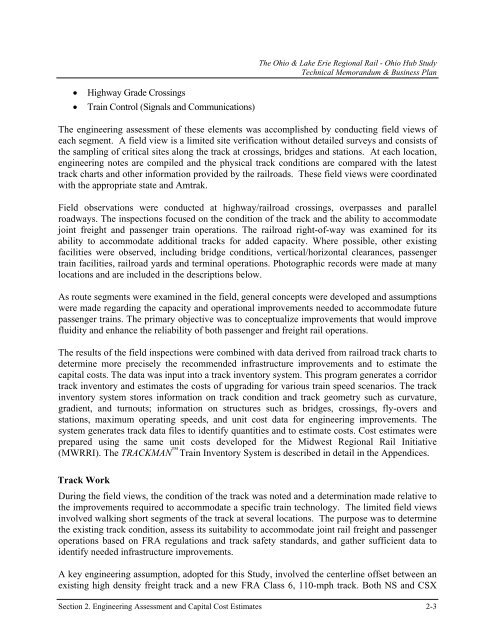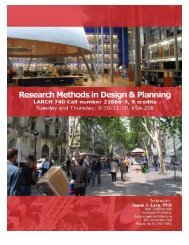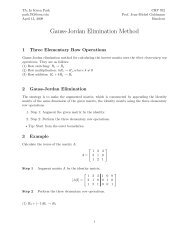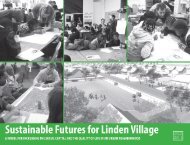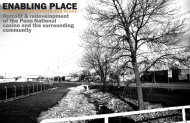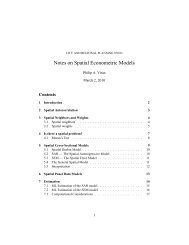Link to 3C Final Report - The Ohio State University
Link to 3C Final Report - The Ohio State University
Link to 3C Final Report - The Ohio State University
Create successful ePaper yourself
Turn your PDF publications into a flip-book with our unique Google optimized e-Paper software.
<strong>The</strong> <strong>Ohio</strong> & Lake Erie Regional Rail - <strong>Ohio</strong> Hub Study<br />
Technical Memorandum & Business Plan<br />
• Highway Grade Crossings<br />
• Train Control (Signals and Communications)<br />
<strong>The</strong> engineering assessment of these elements was accomplished by conducting field views of<br />
each segment. A field view is a limited site verification without detailed surveys and consists of<br />
the sampling of critical sites along the track at crossings, bridges and stations. At each location,<br />
engineering notes are compiled and the physical track conditions are compared with the latest<br />
track charts and other information provided by the railroads. <strong>The</strong>se field views were coordinated<br />
with the appropriate state and Amtrak.<br />
Field observations were conducted at highway/railroad crossings, overpasses and parallel<br />
roadways. <strong>The</strong> inspections focused on the condition of the track and the ability <strong>to</strong> accommodate<br />
joint freight and passenger train operations. <strong>The</strong> railroad right-of-way was examined for its<br />
ability <strong>to</strong> accommodate additional tracks for added capacity. Where possible, other existing<br />
facilities were observed, including bridge conditions, vertical/horizontal clearances, passenger<br />
train facilities, railroad yards and terminal operations. Pho<strong>to</strong>graphic records were made at many<br />
locations and are included in the descriptions below.<br />
As route segments were examined in the field, general concepts were developed and assumptions<br />
were made regarding the capacity and operational improvements needed <strong>to</strong> accommodate future<br />
passenger trains. <strong>The</strong> primary objective was <strong>to</strong> conceptualize improvements that would improve<br />
fluidity and enhance the reliability of both passenger and freight rail operations.<br />
<strong>The</strong> results of the field inspections were combined with data derived from railroad track charts <strong>to</strong><br />
determine more precisely the recommended infrastructure improvements and <strong>to</strong> estimate the<br />
capital costs. <strong>The</strong> data was input in<strong>to</strong> a track inven<strong>to</strong>ry system. This program generates a corridor<br />
track inven<strong>to</strong>ry and estimates the costs of upgrading for various train speed scenarios. <strong>The</strong> track<br />
inven<strong>to</strong>ry system s<strong>to</strong>res information on track condition and track geometry such as curvature,<br />
gradient, and turnouts; information on structures such as bridges, crossings, fly-overs and<br />
stations, maximum operating speeds, and unit cost data for engineering improvements. <strong>The</strong><br />
system generates track data files <strong>to</strong> identify quantities and <strong>to</strong> estimate costs. Cost estimates were<br />
prepared using the same unit costs developed for the Midwest Regional Rail Initiative<br />
(MWRRI). <strong>The</strong> TRACKMAN Train Inven<strong>to</strong>ry System is described in detail in the Appendices.<br />
Track Work<br />
During the field views, the condition of the track was noted and a determination made relative <strong>to</strong><br />
the improvements required <strong>to</strong> accommodate a specific train technology. <strong>The</strong> limited field views<br />
involved walking short segments of the track at several locations. <strong>The</strong> purpose was <strong>to</strong> determine<br />
the existing track condition, assess its suitability <strong>to</strong> accommodate joint rail freight and passenger<br />
operations based on FRA regulations and track safety standards, and gather sufficient data <strong>to</strong><br />
identify needed infrastructure improvements.<br />
A key engineering assumption, adopted for this Study, involved the centerline offset between an<br />
existing high density freight track and a new FRA Class 6, 110-mph track. Both NS and CSX<br />
Section 2. Engineering Assessment and Capital Cost Estimates 2-3


